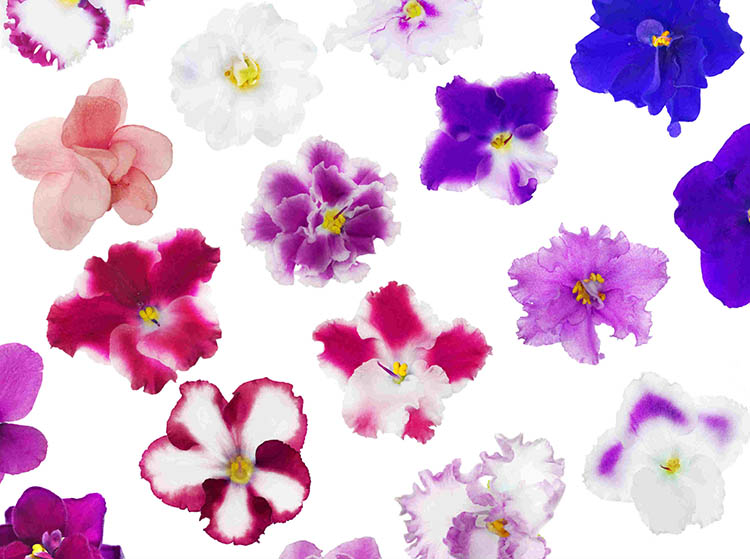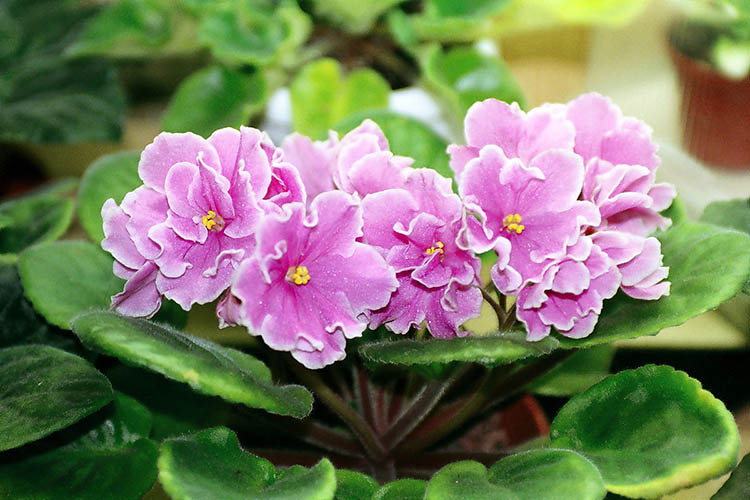Violet: care and landing

Violets are particularly popular with flower growers, and they are decorated not only with window sills. In a special club of fans of violets, incredibly beautiful hybrid varieties are grown, while colorful exhibitions are regularly organized. There are several thousand varieties of such plants, both registered and under cultivation. There are many fairly well-known varieties that have not yet entered the registry, and most often these are hybrids created by random selection.
Violets (Saintpaulias) have a leaf outlet, but they do not have a central shoot. Small flowers have very showy petals of unusual shape. During flowering a large number of flowers bloom, and the violet looks like a bouquet. Color flowers and leaf plates can be very different. The shape of the outlet can vary from strongly terry to simple. Such flowers can be a great decoration for a window sill, as well as a shelving, kitchen apron, etc. If you take care of the Saintpaulia properly, then it can become the main decoration of any room.
How to plant and care at home

When planting a violet, it should be remembered that it prefers a place with good lighting, but at the same time it reacts negatively to the direct rays of the sun. The soil in the pot all the time should be slightly wet, but the stagnation of the liquid should not be allowed. Saintpaulia negatively reacts to too high air humidity, as well as to the wetting of the leaf plates from the sprayer. For hygienic purposes, it is allowed to arrange a shower, but it is rarely necessary to carry out such a procedure. However, it is worth considering that in place of the plant should be put after it dries completely. Water the flower should be well-settled tepid water. It is recommended to water the Saintpaulia through the pallet, it is convenient for the florist and favorably affects the state of the root system.
You also need to remember that the plant does not tolerate drafts and warm air flowing from the heaters. You also need to put a fan away from him. Another violet can not tolerate the lack of love and care towards her, as well as frequent scandals and quarrels of households.
The optimal composition of soil mixture for planting
A substrate suitable for saintpaulia should be acidic, while its composition should include leafy soil, peat, large river sand, which must be taken in a ratio of 5: 3: 1. And it is necessary to pour dried sphagnum and charcoal into it, and it is necessary that their volume does not exceed 10 percent of the total.
In order to retain moisture in such a light substrate, experts advise, add vermiculite and perlite to peat. Once every 12 months, a solution of humate is introduced into the soil, and in winter, spring and autumn, it is fed with special mineral fertilizers intended for violets, which are produced in liquid form. You can not overfeed such flowers.
How to choose a pot and when to do transplanting
Carefully consider the choice of capacity. An earthen room should be such that the roots are not crowded, but at the same time it should not turn sour. For example, for an adult copy it is recommended to prefer a pot, the diameter and height of which will be equal to 10 centimeters. It should be noted that its ? part should occupy the drainage layer.
Flowering can be seen only after the roots completely fill the pot. A young plant is first planted in a pot with a diameter of 6 centimeters. At the bottom there should be a hole for drainage of a sufficiently large size. This flower needs to be transplanted 1 time in 3 years, while the capacity can not be changed, but only to change the substrate, carefully removing the old from the roots.
How to propagate and transplant violet

It is possible to propagate this beautiful flower with leaves, cuttings, seeds, and with the help of rooting peduncle. The most popular method of breeding leaflets. Before rooting, you need to update the slice, for this you need to use a pre-disinfected instrument. After the sheet is immersed in the water cut down. After some time, the roots and callus will appear. When the roots in length reached 4-7 centimeters, the leaf can be planted. It should be covered on top with glass or film. Grown violet planted in an individual pot. Under favorable conditions, flowering can be seen after 12 months.
- Hybrid varieties (chimeras) breed only by peduncles and stepsons, since only they are able to preserve the varietal characteristics of the parent flower. From the outlet the stepson comes off with the help of awls. It is placed in a peat tablet for rooting.
- During transplantation, pay attention to the roots. They must be healthy, white color, alive. A pot must be completely filled with roots. If you remove the root system from a conical pot, it will retain its shape. Due to this property of the plant, an irrigation system has been created, in which an external pillow is created that is moistened through a filter. In this case, the violet should be placed in a larger container in which the moistened soil is located. In it, you must first make a special nest.
- When inspecting the roots, it is necessary to remove the dead roots of a brownish color. Then the plant can be thoroughly washed and transplanted into a new pot by straightening the roots. If all the roots are rotted, then they should be removed by stripping the seedlings to healthy tissue. Sprinkle with active carbon and allow to dry. Put a flower for rooting in sphagnum (has antibacterial properties) or in water.
- In summer, the temperature is about 25 degrees, and in winter - from 18 to 20 degrees. It is best if the humidity of the air does not exceed fifty percent. The duration of the daylight hours at any time of the year should be approximately 10 hours. When flowers appear, the violet will need to be illuminated with fluorescent lamps.
Watering through the pan, it is necessary to drain the excess liquid. If you pour water into the pot, then make sure that it does not fall on the leaves. In summer, watering should be daily, but use a little water, in winter - watered a couple of times in 7 days. A young flower blooms not earlier than 12 months after planting. Duration of flowering - 8 weeks. Fading flowers should be removed. Lack of flowering may indicate the presence of a disease or pests or improper care.